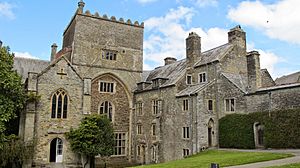Buckland Abbey facts for kids
Buckland Abbey is a very old house in Devon, England. It's about 700 years old! This special building is famous for its links to two important historical figures: Sir Richard Grenville the Younger and Sir Francis Drake. Today, the National Trust looks after Buckland Abbey, keeping it safe for everyone to visit and learn about its past.
Contents
A Home for Monks
Buckland Abbey started as a Cistercian abbey in 1278. An abbey is a place where monks live and pray. It was founded by a kind lady named Amicia, Countess of Devon. This abbey was one of the last Cistercian places built in England.
The church part of the abbey was quite simple. It was about 37.6 meters (123 feet) long. Many parts of this old church are still inside the house today. For example, you can see the arches that held up the tower on the top floor. The monks lived in buildings around a central courtyard called a cloister. These buildings are mostly gone now.
The abbey was given a lot of land when it was founded. It had over 20,000 acres (about 8,097 hectares) of land! This helped the monks grow food and support themselves. In 1337, King Edward III even allowed the monks to build defenses around the abbey. This meant they could protect their home.
In the 1400s, the monks built a huge barn. This barn is called a Tithe Barn and is about 55 meters (180 feet) long. It's still standing today and is a very important historical building.
Buckland Abbey remained a home for monks until King Henry VIII decided to close all the monasteries in England. This event is known as the Dissolution of the Monasteries. The abbey was closed in 1539.
From Abbey to Home
After the abbey was closed, King Henry VIII sold it in 1541. Sir Richard Grenville the Elder bought it. He and his son, Sir Roger Grenville, started turning the abbey into a family home. They renamed it Buckland Greynvile. Sadly, Sir Roger died in 1545 when his ship, the Mary Rose, sank.
His son, also named Richard Grenville, finished changing the abbey into a house by 1576. The Grenville family owned Buckland for 40 years.
Sir Francis Drake's Home
In 1581, Sir Richard Grenville the Younger sold Buckland Abbey. He didn't know that the buyers were secretly working for Sir Francis Drake. Sir Francis Drake was a famous English explorer and sailor. He was the first Englishman to sail all the way around the world! Grenville didn't like Drake, so it was a surprise when Drake became the new owner.
Drake lived in the house for 15 years. The abbey was changed quite a bit to become a comfortable home. For example, some parts of the old church were removed to let more light into the main hall.
Over the years, the house had more changes and repairs. There was a big fire in 1915 and another in 1938. In 1947, Buckland Abbey was given to the National Trust.
Buckland Abbey Today
After being repaired, Buckland Abbey opened to the public in 1951. The National Trust now runs it. You can visit and see many interesting things. The Plymouth City Museum and Art Gallery even keeps some of its collection there. One famous item is "Drake's Drum". Legend says that if England is in danger, the drum will beat by itself!
There are also workshops where people create crafts. The gardens are lovely, with both wild areas and a kitchen garden. You can also see the amazing medieval Great Barn next to the house.
In 2013, a painting at Buckland Abbey was confirmed to be a real Rembrandt self-portrait. Rembrandt was a very famous Dutch painter. This painting is now worth a lot of money!
The Costume Group
A special group called the National Trust Costume Group works at Buckland Abbey. They make amazing Elizabethan costumes. They use old methods and materials, just like people did hundreds of years ago!
They have made a complete costume for Sir Francis Drake. It looks just like the one in his famous portrait. The group is also working on a costume for Lady Drake.
See also
- Drake baronets
- Fuller baronets
- Baron Seaton
- Cestui que









